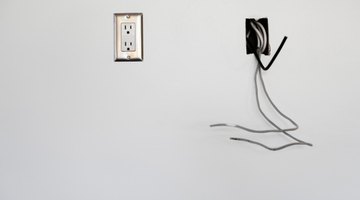What Is the Voltage of Household Electricity?
Electrical voltage can be difficult to understand, especially when the standards are different in each country. In essence, household voltage is the average amount of electrical energy supplied to an outlet. In the U.S.

, there are two standard voltages, one for everyday electrical devices and one for heavy-duty appliances. In other parts of the world, a single voltage for all devices and appliances is the standard.
120 Volts
Standard household outlets in the United States are 120 volts. This voltage is supplied through a single "hot" wire that carries 120 volts. When an electrical item is plugged in, the electricity travels through the device and returns to a "neutral" wire in the outlet. The charge is then carried back to the circuit box and on to the ground where it is neutralized. A second hot wire is available, and technically could provide 240 volts to the outlet, but most electrical devices in the U.S. are not designed for such a high voltage.
240 Volts
Large appliances that require more energy for their operation are supplied by 240 volt outlets. In the U.S., only a few of these higher voltage outlets are usually placed in each home. Appliances such as stoves, air conditioners and clothes dryers use them. The alternating current design of two hot wires of 120 volts each, along with a third neutral wire, make it simple for outlets providing 240 volts for these large appliances to go in homes.
Variations
Although 120 and 240 volts are considered the standard, the actual voltage may vary. This is due in part to the alternating current design. Outlets designated as 120 volts may actually provide 110-170 volts. The 120 volt designation is actually an average of the voltage running through the outlet. The same is true for a 240-volt outlet, which was previously designated as a 220-volt outlet. Power surges, which occur on a regular basis, result in quick sudden spikes of electricity that are much higher than the average voltage. These spikes can damage electrical devices and sometimes even cause fires.
Other Standards
The United States stands apart from many other countries in using 120 as a standard voltage for most home outlets. Most countries have a much higher voltage. The majority of countries in Europe, for example, have a standard voltage of 220-240. This is because it is easier to transmit higher voltages and less copper is required for electric transmission. Although the U.S. is in the minority, some other countries have similar standard voltages in homes, including Canada, Bahamas, Brazil and Vietnam.
References
Photo Credits
- Jupiterimages/Brand X Pictures/Getty Images
- Jupiterimages/Brand X Pictures/Getty Images
More Articles



